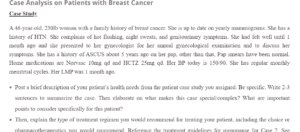Case Analysis on Patients with Breast Cancer
Health Needs
The patient has uncontrolled blood pressure. Although she is a known hypertensive on combination therapy with a calcium channel blocker (Norvasc) and a thiazide diuretic (hydrochlorothiazide), her blood pressure is elevated (150/90mmHg).
The patient also has symptoms of menopause that may be affecting her quality of life. Although she reports regular menstrual cycles, she experiences vasomotor symptoms (hot flushing and night sweats) and genitourinary symptoms, indicating that she may be perimenopausal.
She is also overweight. She weighs 230 lbs.
Discussion
The patient has failed to achieve blood pressure control despite undertaking combination antihypertensive therapy.
Although the patient’s menopausal symptoms make her eligible for hormone therapy, she has a family history of breast cancer. Exogenous estrogen exposure is associated with an increased risk of breast cancer (Yu et al., 2017). Additionally, there is limited evidence to support the safety of hormone therapy in women with a family history of breast cancer (North American Menopause Society [NAMS], 2017). Hormone therapy may, therefore, increase her risk of developing cancer because of estrogen exposure.
Additionally, she is hypertensive and overweight, indicating a risk of cardiovascular disease and macrovascular complications such as myocardial infarction and stroke. Hormone replacement therapy, particularly estrogen replacement, may increase the risk of these cardiovascular events (Salaminia et al., 2019).
Treatment Regimen
Add angiotensin-converting enzyme inhibitor (ACEI) to her current antihypertensive regimen to improve blood pressure control. Introduce Lisinopril 20mg once daily. Counsel on combination therapy adherence.
Prescribe micronized progesterone 300mg for nightly use to relieve hot flashes and night sweats. Micronized progesterone has less effect on breast cancer risk compared to estrogen alone or estrogen-progesterone therapy (NAMS, 2017).
For the genitourinary symptoms, prescribe low-dose vaginal estrogen. In light of her risk of breast cancer, the vaginal formulation minimizes systemic exposure to estrogen and prevents risk augmentation. Alternatively, prescribe oral ospemifene 60mg for use once daily to relieve the genitourinary symptoms (NAMS, 2017).
Introduce antiplatelet therapy to reduce the risk of cardiovascular events. Prescribe Aspirin 75mg once daily. This may lower the additional risk of cardiovascular accidents that may result from hormone replacement.
Offer lipid-lowering therapy. Introduce atorvastatin 20mg once daily for further prevention of cardiovascular disease (Stewart et al., 2017).
Counsel on lifestyle changes, including moderate to severe intensity aerobic exercise, reduced salt intake, and avoidance of saturated fats, alcohol, and smoking (Stewart et al., 2017).
References
North American Menopause Society. (2017). The 2017 hormone therapy position statement of the North American Menopause Society. Menopause, 24(7), 728-753.
Salaminia, S., Mohsenzadeh, Y., Motedayen, M., Sayehmiri, F., & Dousti, M. (2019). Hormone Replacement Therapy and Postmenopausal Cardiovascular Events: A Meta-Analysis. Iranian Red Crescent Medical Journal, 21(2).
Stewart, J., Manmathan, G., & Wilkinson, P. (2017). Primary prevention of cardiovascular disease: A review of contemporary guidance and literature. JRSM cardiovascular disease, 6, 2048004016687211.
Yu, X., Zhou, S., Wang, J., Zhang, Q., Hou, J., Zhu, L., … & Zhong, S. (2017). Hormone replacement therapy and breast cancer survival: a systematic review and meta-analysis of observational studies. Breast Cancer, 24(5), 643-657.
ORDER A PLAGIARISM-FREE PAPER HERE
We’ll write everything from scratch
Question 
Case Analysis on Patients with Breast Cancer
Case Study
A 46-year-old, 230lb woman with a family history of breast cancer. She is up to date on yearly mammograms. She has a history of HTN. She complains of hot flushing, night sweats, and genitourinary symptoms. She had felt well until 1 month ago and she presented to her gynecologist for her annual gynecological examination and to discuss her symptoms. She has a history of ASCUS about 5 years ago on her pap, other than that, Pap smears have been normal. Home medications are Norvasc 10mg qd and HCTZ 25mg qd. Her BP today is 150/90. She has regular monthly menstrual cycles. Her LMP was 1 month ago.

Case Analysis on Patients with Breast Cancer
- Post a brief description of your patient’s health needs from the patient case study you assigned. Be specific. Write 2-3 sentences to summarize the case. Then elaborate on what makes this case special/complex? What are important points to consider specifically for this patient?
- Then, explain the type of treatment regimen you would recommend for treating your patient, including the choice or pharmacotherapeutics you would recommend. Reference the treatment guidelines for menopause for Case 2. See links below. Focus on the drugs, but you can also briefly mention non-pharmaceutical options.
- and explain why. Be sure to justify your response. Why would you select this drug for this patient? Or why would certain options be inappropriate/more appropriate?
- Explain a patient education strategy you might recommend for assisting your patient with the management of their health needs. Be specific and provide examples. Include counselling pearls.
NAMS recommendations for Midlife women
NAMS Non-hormonal management of Menopause
NAMS 2017 Hormone Therapy for Menopause
